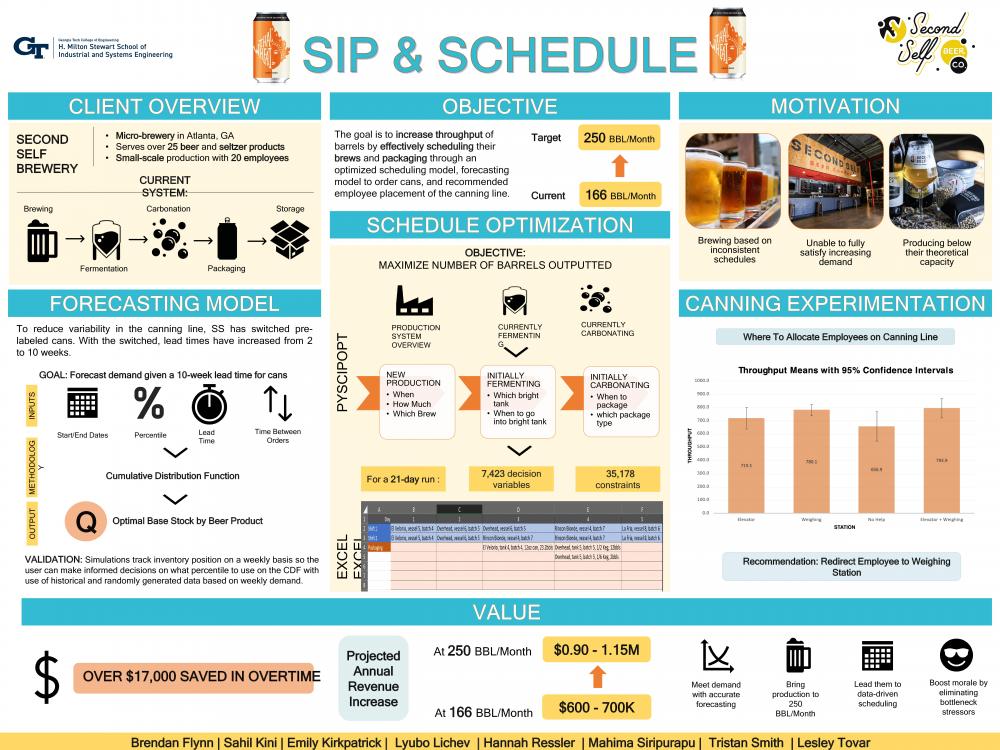Client Context
Second Self (SS) is a micro-brewery located in West Midtown, Atlanta. They serve customers in the southeast of the United States and Puerto Rico. Their facility currently produces beer and seltzer, alongside supplementary products which include tea, coffee, and carbonated water. The current production layout, machinery, number of fermenting tanks, and current scheduling system allow Second Self to reach a monthly production of 166 beer barrels (BBL).
Project Objective
They expressed interest in returning to producing 250 BBL, as they were pre-COVID. Due to their inability to meet their current production goals, Second Self is unable to satisfy demand, accept new contracts, and expand their brand. The main objective of this project is to increase throughput of barrels per month (BBL/month), to help Second Self achieve its goals. Second Self decides their production schedule on a weekly basis based the Head Brewer’s understanding of market demand and contract-based orders. The lack of a data-driven production schedule has led to rushed processes and bottlenecks within the system. Due to the lack of a thorough understanding of demand, certain beers have been produced at the wrong times and sit in tanks for longer than necessary. The current canning line exhibits a lot of variability in terms of process times, anywhere between 4 and 8 hours.
Design Strategy
Our solution accounts for the processing times of various products, uses a pre-labeled cans demand forecasting and simulations model to predict base stock quantity levels, and employs an optimization model which maximizes throughput. In addition, switches to pre-labeled cans and changes to the canning line were accounted for and experimentation was conducted to give SS recommendations on worker allocations. All this information comes together to aid Second Self in bringing their throughput to a greater amount. To validate our optimization model can achieve our expected throughput of 250 BBLs and beyond, we ran a simulation against historical order data. In June of 2017, we found data that showed SS was able to produce over 250 BBLs in a month. They were producing 5 beer types into 3 package types so we inputted this 28-day period with 251BBLs of demand into our model. To allow our model to run effectively but with sufficiently further insight than current methods, we took an iterative approach to scheduling. We set our model to run for 17 days, beginning every Monday. This way SS would have a complete schedule produced for them each week that they would then re-input back into the model for the next iteration. Emulating this cadence, we ran four tests of the model as if we were SS on 5/29/2017, 6/5/2017, 6/12/2017, and 6/19/2017. Our model was able to meet demand with significant opportunity for more output.
Deliverables
This project produced three deliverables for SS:
1. Schedule Optimization Model: Using an optimization solver, we created a model that considers equipment, time, current system state as well as orders. This model outputs a schedule that shows what brew product should be made, at what quantity, what tank it should be placed into, and when it will be packaged. The model maximizes throughput.
2. Pre-Labeled Cans Lead Time Demand Forecasting and Simulations: To account for the can lead time increase when switching over to pre-labeled cans, a demand forecasting tool was created that outputs an optimal base stock quantity for a given beer product. This model uses a cumulative distribution function (CDF) with past order data to create its output. In order to validate the forecasts and to give the user perspective on their choice in percentile, two simulations are shown side by side with the CDF.
3. Canning Line Worker Allocation Recommendations: After spending time learning about the various products, brewing methods, and the overall brewing process through on-site research as well as a literature review, we were able to collect data to create informed process flows for the distinct types of products. This allowed for a deeper understanding of where bottlenecks within the system existed. With the switchover to pre-labeled cans, there was a need to experiment with worker allocation on the canning line. Specifically, looking at how to reallocate workers to different stations to decrease variability and increase throughput on the canning line. We can recommend to SS where they should move workers.


